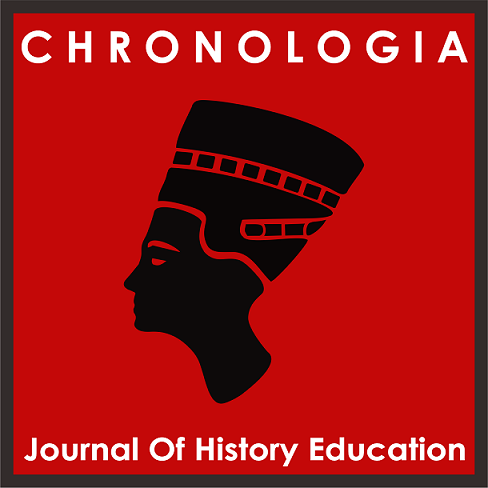Main Article Content
Abstract
This Sea Tribe in general has been known for a long time as a tribe whose life wanders on the high seas as a place for them to live and in meeting their daily needs they depend on nature. The government considers this kind of life as one of the obstacles in the government's development plan. Therefore, during the New Order government a policy was issued to settle the Sea Tribes, including the Sea Tribes in Sungai Buluh Village, which made them have to adapt to an environment that was foreign to them. Departing from these problems, this study aims to determine (1) the origin of the Sea Tribes who were settled in Sungai Buluh Village, (2) the process of relocating the Sea Tribes in Sungai Buluh Village, (3) the life of the Sea Tribes after being resettled to Sungai Buluh Village. The method used is the historical research method which includes the following steps: (1) heuristics, (2) source criticism, (3) interpretation, and (4) historiography. The results of this research: The Sea Tribe who settled in Sungai Buluh Village came from Pilang Island. They have long lived on the coast of Pilang Island and are known as the Baroque People. The relocation process was carried out by moving them to houses that had been built in Sungai Buluh Village as many as 52 houses, besides that they were also fostered in the social, religious, educational and economic fields. Now, the Sea Tribe have mingled and their settlement looks like a typical Malay village with their main livelihood being fishing.
Keywords
Article Details

This work is licensed under a Creative Commons Attribution 4.0 International License.
References
- Abdurrahman , Dudung. (2007). Metodologi Penelitian Sejarah. Yogjakarta: Ar-Ruzz Media
- Arman, Dedi. (2019). Orang Laut dan Potret Kerukunan Beragama di Kepri. Surabaya: Pustaka Media Guru
- Direktorat Pendayagunaan Pesisir dan Pulau-Pulau Kecil. (2020). Suku Laut Mengarungi Kehidupan Selingkar Sampan. Kementrian Kelautan dan Perikanan
- Eli Yati, Nunung. (2011). Keanekaragaman Kekayaan Laut dan Samudra Kita. Klaten: Cempaka Putih
- Marsanto, P Khidir. (2010). Orang Suku Laut dan Orang Melayu di Kepulauan Riau: Sebuah Tafsir Deskriptif-Etnografis. Jurnal Antropologi. 31(3), 224-239
- Proyek Penelitian Bahasa dan Sastra Indonesia dan Daerah Riau 1981/1982. Dialek Bahasa Orang Laut. (Jakarta Timur: Pusat Pembinaan dan Pengembangan Bahasa, 1982)
- Rencana Pembangunan Lima Tahun: Kelima (1989/1990-1993/1994). Propinsi Daerah Tingkat I Riau
- Satria, Arif. (2015). Pengantar Sosiologi Masyarakat Pesisir. Jakarta: Yayasan Obor Indonesia
- Wijaja, Sjarief. (2019). Transfromasi Budaya Maritim Berbasis Inovasi Teknologi. Jakarta: Amfard Press
References
Abdurrahman , Dudung. (2007). Metodologi Penelitian Sejarah. Yogjakarta: Ar-Ruzz Media
Arman, Dedi. (2019). Orang Laut dan Potret Kerukunan Beragama di Kepri. Surabaya: Pustaka Media Guru
Direktorat Pendayagunaan Pesisir dan Pulau-Pulau Kecil. (2020). Suku Laut Mengarungi Kehidupan Selingkar Sampan. Kementrian Kelautan dan Perikanan
Eli Yati, Nunung. (2011). Keanekaragaman Kekayaan Laut dan Samudra Kita. Klaten: Cempaka Putih
Marsanto, P Khidir. (2010). Orang Suku Laut dan Orang Melayu di Kepulauan Riau: Sebuah Tafsir Deskriptif-Etnografis. Jurnal Antropologi. 31(3), 224-239
Proyek Penelitian Bahasa dan Sastra Indonesia dan Daerah Riau 1981/1982. Dialek Bahasa Orang Laut. (Jakarta Timur: Pusat Pembinaan dan Pengembangan Bahasa, 1982)
Rencana Pembangunan Lima Tahun: Kelima (1989/1990-1993/1994). Propinsi Daerah Tingkat I Riau
Satria, Arif. (2015). Pengantar Sosiologi Masyarakat Pesisir. Jakarta: Yayasan Obor Indonesia
Wijaja, Sjarief. (2019). Transfromasi Budaya Maritim Berbasis Inovasi Teknologi. Jakarta: Amfard Press

